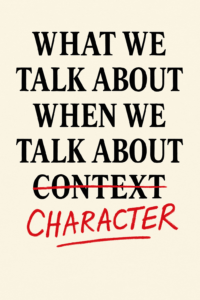There’s a moment, reading Homi Bhabha’s takedown of Fredric Jameson in The Location of Culture, when something clicks—not just in the argument, but in the style. Jameson is trying to solve culture like an equation: assign values, isolate variables, and arrive at a coherent output. Bhabha, meanwhile, is operating in a different mathematical universe entirely. He’s not solving; he’s deriving. His meanings shift, flow, contradict themselves, curve around colonial histories and linguistic fractures.
That’s when it hit me:
Jameson is doing algebra. Bhabha is doing calculus.
Jameson’s work, especially in Postmodernism, or, the Cultural Logic of Late Capitalism, constructs a kind of conceptual grid—a structured model for understanding cultural production under late capitalism. At one point, he tries to extract the entire cultural logic of Chinese revolutionary art from a few translated lines of a poem. Bhabha doesn’t just critique him—he highlights the large leap it takes to derive sweeping cultural meaning from such limited textual fragments, especially when filtered through translation and Western assumptions. It’s a perfect example of algebraic thinking: plug in limited data, assume fixed meaning, and solve for culture.
Bhabha won’t have it. The Location of Culture demands a theory in motion: layered, recursive, nonlinear. He’s writing from the margins, where meaning keeps shifting.
If algebra asks: what is the value? Calculus asks: how is it changing? Bhabha is telling us that culture can’t be understood without motion, history, and the messiness of change. Culture, for Bhabha, isn’t inherited wholesale—it’s negotiated in what he calls the Third Space: that unstable zone where meanings are constantly rewritten, identities shift by degrees, and history doesn’t sit still. It’s culture in motion—the kind you trace, not solve.
I found this perspective reinforced, unexpectedly, in Ruha Benjamin’s work. A sociologist of science and technology, Benjamin exposes how supposedly neutral systems—algorithms, predictive policing, medical technologies—inherit the biases of their creators. In Race After Technology, she warns against the “New Jim Code,” where racism is reproduced through technical design under the guise of objectivity.
Like Bhabha, Benjamin insists that to understand a system, you have to track not just what it does, but how it got that way. Present-day outcomes, she argues, are derivatives of historical forces. You can’t read a data point—or a person—without understanding its slope: the embedded assumptions, the legacy code, the inertia of injustice. She, too, resists the grid. Her critique unfolds across vectors—of race, design, history, and power—all moving.
As I thought through this fun thought experiment, I wondered: if Jameson is algebra and Bhabha is calculus, does that make Gayatri Spivak’s Can the Subaltern Speak? the equivalent of imaginary numbers? Not quite real, not quite unreal, but necessary to complete the system. Spivak, a literary theorist and postcolonial scholar, famously questions whether the subaltern—the colonized subject denied access to institutional power—can ever be fully represented within Western discourse.
Her answer is purposefully paradoxical: the moment the subaltern is heard, she is no longer subaltern. This epistemic instability mirrors the strangeness of imaginary numbers—unintuitive, elusive, but essential for solving real problems. Spivak isn’t offering closure. You can’t solve her. But she makes sure we don’t mistake solvability for truth.
Thinking in motion—historically, culturally, structurally—is hard. It’s messy. It rarely resolves into tidy answers. But it’s the only way to read honestly.
If Jameson gives us a model, Bhabha gives us a method. Benjamin updates that method for the digital age, showing how inequality is encoded, inherited, and disguised. And Spivak reminds us that some voices remain outside the solvable system entirely.
Culture doesn’t sit still long enough to be solved. And maybe that’s the point.




